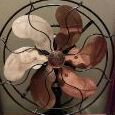Andrew, it does not require any special equipment to rewind the motor.
You will need to 'diagram' the motor. this is done by drawing a linear representation of the stator slots.
When you remove the old windings count the turns. Be aware of the fact that those windings are tapped, which means that leads are brought out at certain turns. Essentially, there are two sets of run windings per pole.
The first set of windings you pull out are the start windings. They are not tapped and they are of a smaller diameter
Measure the diameters of the wire used in the start windings and run windings.
Draw the wire representation in the slots of your diagram for both the start and run windings. You will note the number of slots the start windings are offset from the run windings. In most modern motors this offset will be even, but on some older motors, wound for one rotation, it is not.
You will get the same number of opportunities as your motor has poles to get the turns count, tap positions and how the wire lies in the slot to get this correct and exactness of counts is important, but not super critical. Just make the new coils as close to the old ones as possible.
A winding form can be as simple as four nails on a board. You will need several to be able to replicate the various coil sizes that your motor uses.
Slot liners need to be made. Examine the old ones to see how they are made. I have tried different methods of slot liner construction and materials, but my goto is 0.010" fishpaper. Cuff the ends, it will help them stay in place.
Now begin laying in the new coils. Patience is key. I bring all my wires out on the same side of the stator.
I will use the terminology start and finish to describe the coil leads.
When all the run windings are in you will have a lot of ends sticking out. Using a meter is advised, as a sanity check, when connecting the coils. On the concentric coil ends, do not connect the start of the innermost coil. Connect the finish of the inner coil to the start of the next coil, the finish of that coil to the start of the next coil, and so on for each pole. Now you have the start and finish of each pole sticking out, along with your speed taps connected similarly.
Do not connect the start of the first pole coils. connect the finish of the first pole to the finish of the next pole, the start of that pole to the start of the next, the finish of that pole to the finish of the next pole until you have only two ends per speed sticking out. Drink a beverage of your choice.
Now lay in the start windings. You may choose to put a separator liner between th start and run windings.
Connect the coils of the start windings similarly to the run windings.
Now you have two ends of each winding sticking out. How they are connected will determine the direction your motor turns. I use a short piece of large copper pipe suspended with fishing line and a swivel to check rotation.
Arbitrarily pick an end of the run and start, connect them as common, connect the other ends as well. Put power through a variac to your motor, suspend the copper pipe in the stator and turn the power up until the pipe begins to rotate. If rotation is backwards, switch up how you picked common.
Make your headwire connections, lash the windings down nice and neat, spray it with insulating varnish and bake it by trickling current through. Don't over amp your windings! Use a meter. Save yourself a bit of trouble and mask the I.D. and O.D. of the stator before varnishing it.
Congratulations! You just successfully rewound your first motor!


